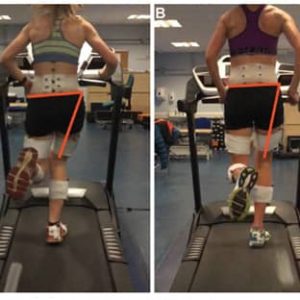Mechanisms Underlying Running-Related Injury
It has been shown that approximately 50% of runners become injured annually. Importantly, most of these problems can be categorised as one of a small number of injuries, including kneecap pain, Achilles Tendon pain, iliotibial band syndrome and pain at the front of the shin. This research is being carried out to understand the biomechanical mechanisms which underlie common running injuries and to use this understanding to develop new physiotherapy treatments.
In a recently completed study, we compared movement patterns between 72 injured and 36 healthy runners. This research showed that injured runners tended to demonstrate an alteration in the movement of their pelvis. This pattern was characterised by a dropping of the pelvis away from the stance limb (as shown in LHS figure). In a subsequent study, we demonstrated that a simple step rate intervention could be used to reduce pelvic drop and that this reduced pain, enabling the participants to return to running.
We have other ongoing research which is investigating the muscle coordination patterns which are associated with pelvic drop. This research suggests that overactivity of the adductor muscles (on the inside of the thigh) may lead to altered pelvic movements and therefore may play a role in running injury.
This work is part of a larger portfolio of projects which is looking at the movement and muscle patterns which underlie running-related injury. The insights gained from this research are being used to continually improve the running performance service offered by the University of Salford.
Team
Dr Niamh Gill
